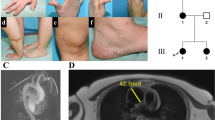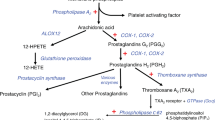Abstract
Mutations in LMAN1 (also called ERGIC-53) result in combined deficiency of factor V and factor VIII (F5F8D), an autosomal recessive bleeding disorder characterized by coordinate reduction of both clotting proteins1. LMAN1 is a mannose-binding type 1 transmembrane protein localized to the endoplasmic reticulum–Golgi intermediate compartment (ERGIC; refs. 2,3), suggesting that F5F8D could result from a defect in secretion of factor V and factor VIII (ref. 4). Correctly folded proteins destined for secretion are packaged in the ER into COPII-coated vesicles5, which subsequently fuse to form the ERGIC. Secretion of certain abundant proteins suggests a default pathway requiring no export signals (bulk flow; refs. 6,7). An alternative mechanism involves selective packaging of secreted proteins with the help of specific cargo receptors8,9,10,11,12,13. The latter model would be consistent with mutations in LMAN1 causing a selective block to export of factor V and factor VIII. But ∼30% of individuals with F5F8D have normal levels of LMAN1, suggesting that mutations in another gene may also be associated with F5F8D14,15. Here we show that inactivating mutations in MCFD2 cause F5F8D with a phenotype indistinguishable from that caused by mutations in LMAN1. MCFD2 is localized to the ERGIC through a direct, calcium-dependent interaction with LMAN1. These findings suggest that the MCFD2-LMAN1 complex forms a specific cargo receptor for the ER-to-Golgi transport of selected proteins.
This is a preview of subscription content, access via your institution
Access options
Subscribe to this journal
Receive 12 print issues and online access
$209.00 per year
only $17.42 per issue
Buy this article
- Purchase on Springer Link
- Instant access to full article PDF
Prices may be subject to local taxes which are calculated during checkout





Similar content being viewed by others
Accession codes
References
Ginsburg, D. Hemophilia and Other Disorders of Hemostasis. in Emery and Rimoin's Principles and Practice of Medical Genetics vol. II. 1926–1958 (Churchill Livingstone, New York, 2002).
Arar, C. et al. ERGIC-53, a membrane protein of the endoplasmic reticulum-Golgi intermediate compartment, is identical to MR60, an intracellular mannose-specific lectin of myelomonocytic cells. J. Biol. Chem. 270, 3551–3553 (1995).
Itin, C., Roche, A.C., Monsigny, M. & Hauri, H.P. ERGIC-53 is a functional mannose-selective and calcium-dependent human homologue of leguminous lectins. Mol. Biol. Cell 7, 483–493 (1996).
Nichols, W.C. et al. Mutations in the ER-Golgi intermediate compartment protein ERGIC-53 cause combined deficiency of coagulation factors V and VIII. Cell 93, 61–70 (1998).
Schekman, R. & Orci, L. Coat proteins and vesicle budding. Science 271, 1526–1533 (1996).
Wieland, F.T., Gleason, M.L., Serafini, T.A. & Rothman, J.E. The rate of bulk flow from the endoplasmic reticulum to the cell surface. Cell 50, 289–300 (1987).
Martinez-Menarguez, J.A., Geuze, H.J., Slot, J.W. & Klumperman, J. Vesicular tubular clusters between the ER and Golgi mediate concentration of soluble secretory proteins by exclusion from COPI-coated vesicles. Cell 98, 81–90 (1999).
Malkus, P., Jiang, F. & Schekman, R. Concentrative sorting of secretory cargo proteins into COPII-coated vesicles. J. Cell Biol. 159, 915–921 (2002).
Kuehn, M.J., Herrmann, J.M. & Schekman, R. COPII–cargo interactions direct protein sorting into ER-derived transport vesicles. Nature 391, 187–190 (1998).
Muniz, M., Morsomme, P. & Riezman, H. Protein sorting upon exit from the endoplasmic reticulum. Cell 104, 313–320 (2001).
Nehls, S. et al. Dynamics and retention of misfolded proteins in native ER membranes. Nat. Cell Biol. 2, 288–295 (2000).
Springer, S. et al. The p24 proteins are not essential for vesicular transport in Saccharomyces cerevisiae. Proc. Natl. Acad. Sci. USA 97, 4034–4039 (2000).
Belden, W.J. & Barlowe, C. Role of Erv29p in collecting soluble secretory proteins into ER-derived transport vesicles. Science 294, 1528–1531 (2001).
Neerman-Arbez, M. et al. Molecular analysis of the ERGIC-53 gene in 35 families with combined factor V-factor VIII deficiency. Blood 93, 2253–2260 (1999).
Nichols, W.C. et al. ERGIC-53 gene structure and mutation analysis in 19 combined factors V and VIII deficiency families. Blood 93, 2261–2266 (1999).
Fiedler, K. & Simons, K. Characterization of VIP36, an animal lectin homologous to leguminous lectins. J. Cell Sci. 109 (Pt 1), 271–276 (1996).
Pipe, S.W., Morris, J.A., Shah, J. & Kaufman, R.J. Differential interaction of coagulation factor VIII and factor V with protein chaperones calnexin and calreticulin. J. Biol. Chem. 273, 8537–8544 (1998).
Hebert, D.N., Foellmer, B. & Helenius, A. Glucose trimming and reglucosylation determine glycoprotein association with calnexin in the endoplasmic reticulum. Cell 81, 425–433 (1995).
Lander, E.S. & Botstein, D. Homozygosity mapping: a way to map human recessive traits with the DNA of inbred children. Science 236, 1567–1570 (1987).
Nichols, W.C. et al. Linkage of combined factors V and VIII deficiency to chromosome 18q by homozygosity mapping. J. Clin. Invest. 99, 596–601 (1997).
Kruglyak, L., Daly, M.J. & Lander, E.S. Rapid multipoint linkage analysis of recessive traits in nuclear families, including homozygosity mapping. Am. J. Hum. Genet. 56, 519–527 (1995).
Levy, G.G. et al. Mutations in a member of the ADAMTS gene family cause thrombotic thrombocytopenic purpura. Nature 413, 488–494 (2001).
Deka, N. et al. Repetitive nucleotide sequence insertions into a novel calmodulin-related gene and its processed pseudogene. Gene 71, 123–134 (1988).
Oeri, J., Matter, M., Isenschmid, H., Hauser, F. & Koller, F. Angeborener mangel an faktor V (parahaemophilie) verbunden mit echter haemophilie A bein zwei brudern. Med. Probl. Paediatr. 1, 575–588 (1954).
Munro, S. & Pelham, H.R. A C-terminal signal prevents secretion of luminal ER proteins. Cell 48, 899–907 (1987).
Lewis, M.J., Sweet, D.J., & Pelham, H.R. The ERD2 gene determines the specificity of the luminal ER protein retention system. Cell 61, 1359–1363 (1990).
Semenza, J.C., Hardwick, K.G., Dean, N. & Pelham, H.R. ERD2, a yeast gene required for the receptor-mediated retrieval of luminal ER proteins from the secretory pathway. Cell 61, 1349–1357 (1990).
Vollenweider, F., Kappeler, F., Itin, C. & Hauri, H.P. Mistargeting of the lectin ERGIC-53 to the endoplasmic reticulum of HeLa cells impairs the secretion of a lysosomal enzyme. J. Cell Biol. 142, 377–389 (1998).
Sussman, D.J. & Milman, G. Short-term, high-efficiency expression of transfected DNA. Mol. Cell Biol. 4, 1641–1643 (1984).
Moussalli, M. et al. Mannose-dependent endoplasmic reticulum (ER)-Golgi intermediate compartment-53-mediated ER to Golgi trafficking of coagulation factors V and VIII. J. Biol. Chem. 274, 32539–32542 (1999).
Acknowledgements
We thank E. Smith for assistance in generating monoclonal antibodies, L. Chang and J. Liu for assistance with the confocal microscope and S.J. Weiss and A. Saltiel for comments on the manuscript. This work was supported in part by grants from the US National Institutes of Health to D.G., W.C.N. and R.J.K. B.Z. is a Judith Graham Pools Postgraduate Fellow of the National Hemophilia Foundation. M.A.C is the recipient of a research fellowship from the Heart and Stroke Foundation of Canada. D.G. and R.J.K. are investigators of the Howard Hughes Medical Institute.
Author information
Authors and Affiliations
Corresponding author
Ethics declarations
Competing interests
The authors declare no competing financial interests.
Supplementary information
Rights and permissions
About this article
Cite this article
Zhang, B., Cunningham, M., Nichols, W. et al. Bleeding due to disruption of a cargo-specific ER-to-Golgi transport complex. Nat Genet 34, 220–225 (2003). https://doi.org/10.1038/ng1153
Received:
Accepted:
Published:
Issue Date:
DOI: https://doi.org/10.1038/ng1153
This article is cited by
-
Combined transcriptome and proteome profiling of the pancreatic β-cell response to palmitate unveils key pathways of β-cell lipotoxicity
BMC Genomics (2020)
-
Improved secretion of glycoproteins using an N-glycan-restricted passport sequence tag recognized by cargo receptor
Nature Communications (2020)
-
Proteome and Secretome Dynamics of Human Retinal Pigment Epithelium in Response to Reactive Oxygen Species
Scientific Reports (2019)
-
A salivary EF-hand calcium-binding protein of the brown planthopper Nilaparvata lugens functions as an effector for defense responses in rice
Scientific Reports (2017)
-
Missense mutations near the N-glycosylation site of the A2 domain lead to various intracellular trafficking defects in coagulation factor VIII
Scientific Reports (2017)



